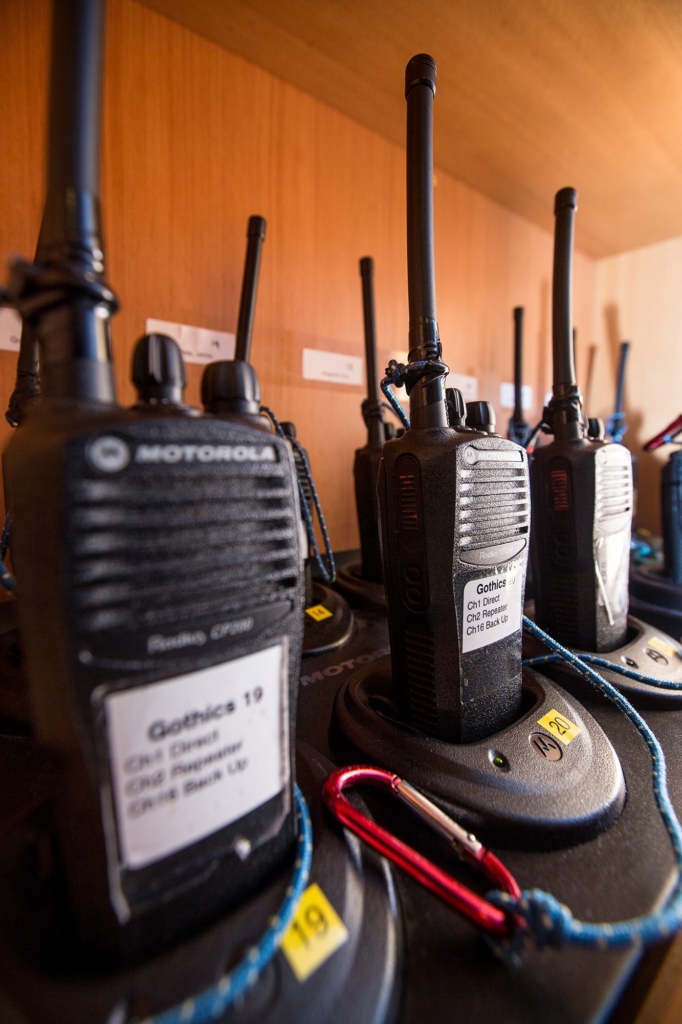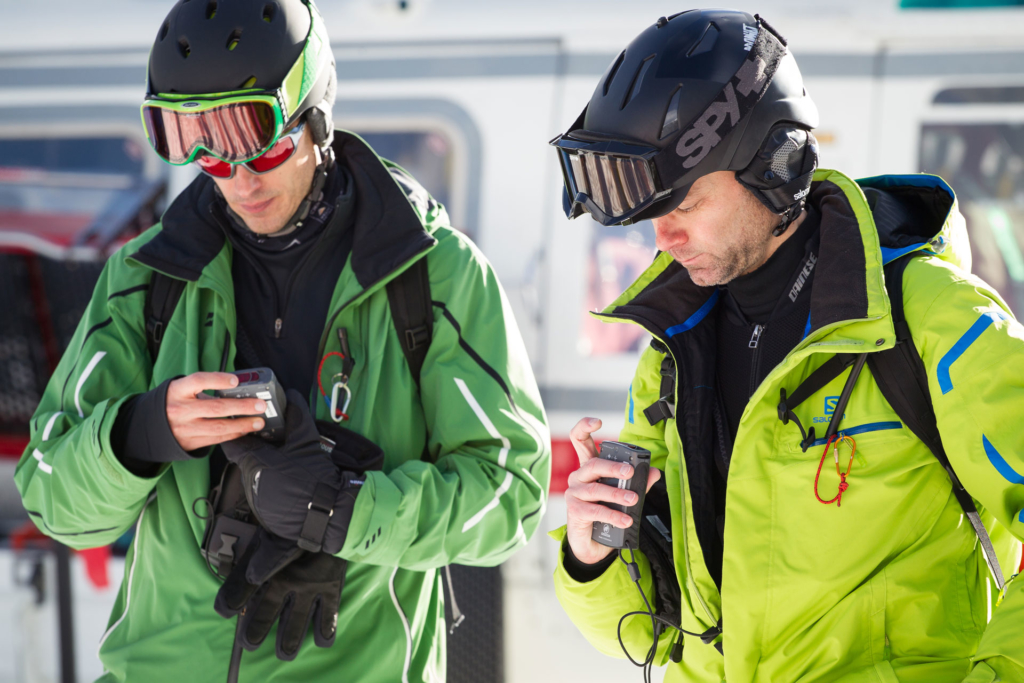– November 17, 2022 | Words by Alison Jones –
If you were to draw a Venn diagram of nature and tech, avalanche transceivers would live firmly within the overlap.
With 11 destinations operating simultaneously each winter, CMH hosts more people heli-skiing on any given day than any other mountain operator in the world. From a safety technology perspective, that makes us the largest and most regular user of avalanche transceivers out there.
That means we have a powerful pool of experience and data for manufacturers of avalanche safety equipment to tap into.
Every single day for nearly five months of the year, there are more than 400 guests and guides across CMH using avalanche transceivers. Our skiers and riders put these life-saving devices through all types of weather conditions and situations, and our guides can give firsthand feedback about performance and reliability.
Because of this, we’ve built a longstanding partnership with outdoor gear manufacturer, Mammut, to help design and test the avalanche transceivers used on every CMH trip. This partnership supports our more than half-century obsession with uplevelling our safety practices and products, and simultaneously buoys Mammut’s ability to constantly test and innovate its technology.
We call that a win-win for users of transceiver technology everywhere.
‘All the gear but no idea’ doesn’t fly here
Layering up in jackets, gloves and boots, a band of newly arrived guests prepare for their first heli-skiing flight. Between their thermals and outer jacket, the guests learn how to slip on one particularly essential piece of gear: a black rectangle with an electronic screen that slides into a slim harness worn around the upper body.
You’d be mistaken if you thought the small devices were smartphones – they’re a similar size and shape. But thankfully, they’re something much more fitting for the environment.
Say hello to your backcountry buddy: your avalanche transceiver. This handheld device sends and receive signals and can be used as a valuable search and rescue tool in an avalanche.
Before you get your first taste of BC powder, a guide takes you through general snow and helicopter safety, as well as an on-snow practice to learn how to use your avalanche transceiver. Everyone from newbies to Million Footers will gather outside the lodge around the guide; a quiet ensues, and so begins the CMH Safety Briefing.
All guests receive this snow safety training upon arrival at CMH. Regardless of how many times you’ve heli-skied or the number of vertical feet you’ve notched, it’s a requirement. Every time.
This indoctrination into the world of safety at CMH, including the training on avy tech, is akin to understanding the role of a life vest during a swim lesson – when playing in the ever-changing elements, knowing how to use your safety gear reigns supreme.
A powerful pack
If you want to have a good time in the backcountry, you need to use the right equipment in the right way – and we’re not just talking about the plank(s) on your feet.
All CMH skiers and riders wear a guest safety pack which holds a shovel and probe. Everyone also wears an avalanche transceiver and carries a two-way radio.
This gear is included with every trip, as well as the training to know how to use it.
The contents of our safety pack are the result of more than 55 years spent honing the products that best align with safe backcountry practices and off-piste peace of mind.
Our pick of transceivers
So, what’s at the top of our list of go-to equipment?
Enter Mammut: An experienced manufacturer of technical gear and outerwear for skiing, mountaineering, hiking, climbing and all-around gear pros in specialized outdoor equipment. For somewhere around two decades, we’ve partnered with Mammut to help design and test the avalanche transceivers worn by both our guests and guides.
We use the Mammut Barryvox S – a powerful and intuitive transceiver with a simple interface allowing for a smooth learning curve for any level of backcountry skier. Measuring 115mm x 67mm (4.5” x 2.6”), it’s an effective piece of lightweight tech. It’s often heralded as the gold standard in accessible equipment due to its ease of user experience yet still high quality.
The tech is also constantly improving. With so many CMH heli-skiers using the Barryvox S each day, we provide ongoing feedback to Mammut on how to maximize its technology. This informs their teams of real-life use that help shape the development of the next generation of avalanche safety devices.

Safety equipment included on every CMH trip:
- Mammut Avalanche Transceiver: This is used for both send (transmits a signal to help others find you) and seek (searches for the signal of someone buried) modes.
- Safety pack: Inside, there is a snow probe (a collapsible, tent-like pole that, when extended, is used to locate a person buried in snow) and a lightweight, compact shovel.
- Radio: Carried by every guest, the radios allow you to easily communicate with your guide and add an extra layer of safety
Optional to rent:
Mammut AFD : An optional addition for any guest who wants to ski or ride with an avalanche flotation device (AFD). These are available for rent upon request at the time of booking.
Avalanche conditions are dynamic, but so too is our collective tech
So, we’ve got quality equipment from the likes of Mammut; thorough safety training for every guest (on every trip); and extensive knowledge from a legion of ACMG, IFMGA and CSGA Guides.
There are a few more pieces to this puzzle yet.
One of the best ways to make good decisions about where we ski and ride each day is to look at the hard data. We do this by using information collected from remote telemetry weather stations.
We’ve strategically placed these weather stations in several CMH tenures, where they then transmit data via a radio repeater network. Some also have real-time webcams for live-feed visuals of current conditions.
We also have a dedicated guide and a separate helicopter to monitor snow safety. All CMH destinations have a snow safety team that assesses the snowpack, evaluates the safety of planned terrain, manages avalanche hazards, and finds the best snow conditions throughout the day for you to enjoy.
This is an industry-leading practice and one we’re incredibly proud of spearheading.

Powder dumps meet data dumps
So, what do we do with all this intel?
Our team of guides collates the information to gain insight into the most up-to-date wind, temperature and snowpack stats and check for visibility and flying conditions.
Every evening, all 12 CMH destinations throughout British Columbia meet via conference call to share information and live observations from the day.
On top of this, we add review insights from an industry-wide avalanche information-sharing initiative called the ‘INFO-ex.’ This is a collective system where all snow operators in the province — heli-skiing, cat-skiing, and ski resorts — submit avalanche observations, weather and snowpack data to Avalanche Canada, the national body that facilitates public avalanche safety.
Heli-skiing X (safety + tech) = a good day in the mountains
All in all, this collective wealth of information provides us with informed decision-making for the best and safest places to ski within our 3 million acres of terrain each day.
While you’ll always hear us talk about the unique ability to unplug while heli-skiing with us, it’s safe to say that the inclusion of integral pieces of tech, like avalanche transceivers, in the great outdoors will always be a good thing.